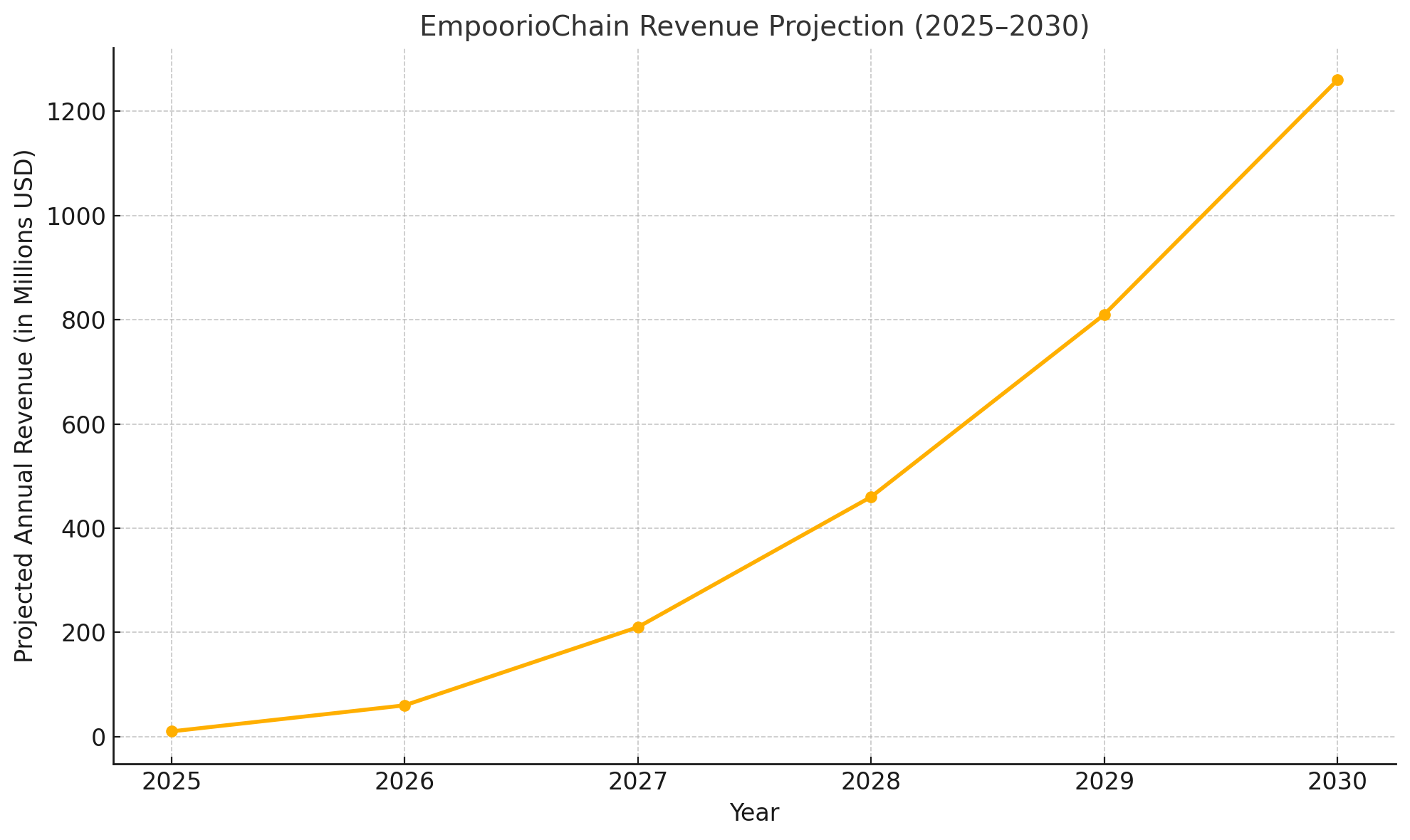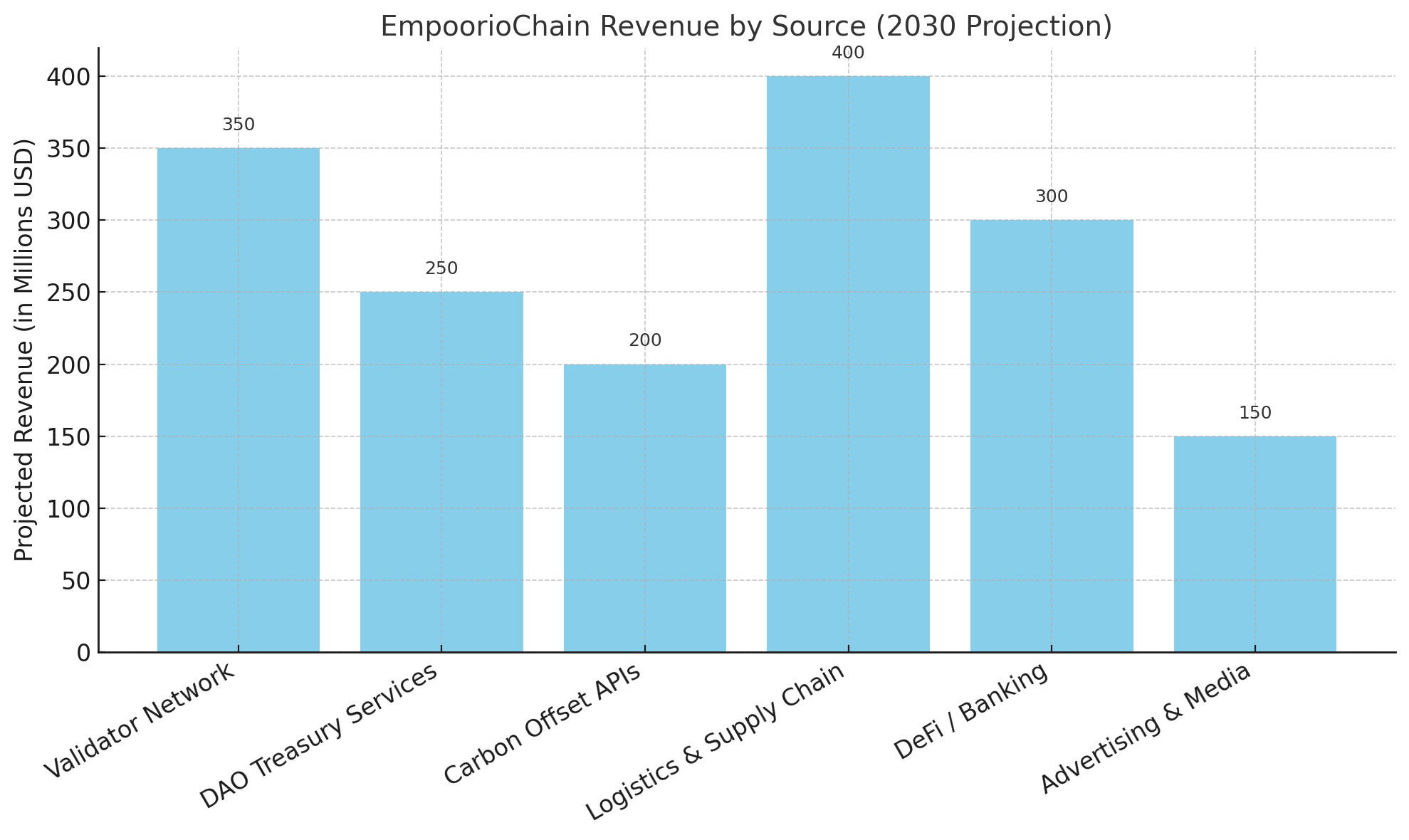EmpoorioChain
The Modular Blockchain for Programmable Economies
Problem
Most blockchains are either overly monolithic or fragmented. They lack sector-specific modules, programmable identity layers, sustainability accounting, and governance transparency. These gaps limit institutional adoption, cross-sector integration, and real-world economic applications—especially in areas like logistics, AI, and public infrastructure.
- Rigid, monolithic architecture not adaptable to diverse industries
- Absence of integrated sustainability metrics or carbon footprint tools
- Fragmented DAO tooling and governance inconsistencies
- Lack of verifiable digital identity for regulated participation
- Low interoperability across chains and external enterprise systems
Solution
EmpoorioChain provides a modular, multichain-ready blockchain framework where governance, carbon tracking, treasury logic, and cross-chain operability are integrated at runtime. It supports scalable, sovereign ecosystems with native incentives, traceability, and compliance—all programmable through open smart modules and powered by the DracmaS token.
- Sector-specific modules for finance, streaming, logistics, AI, and more
- Native integration of carbon metrics and eco-incentive tracking
- On-chain quadratic voting and treasury automation
- Self-sovereign identity (SSI) framework with verifiable credentials
- Cross-chain operability via IBC, Axelar, EVM bridges, and WrappedDMS
Overview
EmpoorioChain is a high-performance, modular Layer 1 blockchain engineered for programmable coordination at scale. It empowers developers, DAOs, and institutions to build and operate fully sovereign decentralized ecosystems that are scalable, carbon-aware, and interoperable by default.
Designed in Rust and optimized for asynchronous processing, EmpoorioChain offers a runtime composed of upgradable, sector-specific modules. These modules enable features such as decentralized identity, carbon scoring, programmable treasuries, quadratic voting, and multichain operability through native bridges. Its architecture is tailored for use cases ranging from micropayments in streaming platforms to traceable logistics and compliance-aware DeFi.
Technologies Used
EmpoorioChain is architected using technologies that are scalable, secure, and built for the modular Web3 era. Each component is selected to ensure performance, upgradability, and compatibility with the future of programmable digital infrastructure.
- Rust: High-performance systems language with strong memory safety and concurrency—ideal for blockchain runtimes.
- Solidity: Industry-standard for smart contracts on EVM-compatible chains—ensuring wide developer accessibility.
- WASM: WebAssembly support enables cross-platform, modular execution and seamless upgradability of on-chain logic.
- TypeScript: Modern web development for SDKs, dApps, and frontends with type-safe integration across modules.
- GraphQL / REST: API flexibility for querying on-chain data efficiently and supporting enterprise integrations.
- IBC / Axelar: Native interoperability protocols for secure cross-chain communication and asset bridging.
- ZK / PQC: Zero-knowledge proofs and post-quantum cryptography to ensure privacy, scalability, and quantum resilience.
Core Modules
Business Model
EmpoorioChain is a sovereign blockchain economy designed for scalability, interoperability, and real-world economic capture. Its business model combines protocol-level monetization, modular enterprise services, and incentivized ecosystem loops—all orchestrated by the DracmaS token.
Protocol Revenues
- DracmaS gas & transaction fees (on-chain execution)
- Validator registration & uptime incentives/slashing
- Smart contract deployment & execution tolls
- Native bridge operations & cross-chain interoperability fees
- Staking-based participation in emission and treasury cycles
Enterprise Monetization
- Modular licensing for SSI, ESG compliance, treasury & carbon tools
- Custom deployments for governments, fintechs, and logistics networks
- White-label SDKs for embedded DeFi & identity solutions
- Subscription models for regulatory sandbox features
- Carbon offset APIs with verifiable on-chain traceability
Ecosystem Value Flows
- Revenue-sharing with dApps (MooSik, Nooia, Eoonia Bank, etc.) via DracmaS
- DAO-governed emissions for app rewards, bounties, and adoption incentives
- Programmable token flows to creators, curators, and compute providers
- Smart royalties, NFT integrations, and Proof-of-Engagement mechanics
- Cross-app token economies built around carbon, reputation, and governance
Strategic Highlights:
- Multi-revenue architecture: EmpoorioChain earns from protocol usage, business tools, and cross-sector data services.
- Composable tokenomics: DracmaS enables programmable revenue flows tailored by sector or stakeholder.
- Carbon-based monetization: Carbon scores and offsets unlock a new economic dimension with ESG compliance baked in.
- DAO-aligned incentives: Treasury logic ensures sustainability, transparency, and fairness in revenue distribution.
- Built-in interoperability: Revenues flow across multichain systems, extending EmpoorioChain’s impact and market access.
5-Year Projection (2025–2030)
- Global Infrastructure Reach: EmpoorioChain aims to become the foundational Layer 1 for digital economies across finance, logistics, AI, governance, and identity—targeting 500M+ end users and 100+ sovereign DAOs by 2030.
- Technical Performance: Over 10 million transactions per second through native sharding, optimistic rollups, and asynchronous execution with sub-30ms finality under load-tested conditions.
- Validator and Ecosystem Scale: 5,000+ validators, 250+ ecosystem apps, and multi-region node distribution across every continent—including compliance-ready nodes for public infrastructure and enterprise use.
- Decentralized Compliance & Carbon Leadership: Real-time carbon impact auditing built into protocol layer; 1 billion+ eco-audited transactions yearly with 90%+ automated carbon offset reporting by partner DAOs and logistics networks.
- Projected Valuation: Targeting $18B–$30B fully diluted valuation by 2030, driven by programmable treasury flows, global institutional adoption, and the vertical integration of the DracmaS token as both native gas and economic logic engine.
Competitive Landscape
- Polkadot: Modular but lacks native sustainability
- Cosmos: Interoperable, but fragmented governance
- Ethereum: Mature, but costly and not eco-optimized
- Near: Fast, but limited institutional tools
- Avalanche: High throughput, low modularity
EmpoorioChain combines their strengths with native SSI, eco-scoring, and programmable governance via DracmaS.
Team & Leadership
EmpoorioChain is built by a multidisciplinary team of blockchain engineers, product architects, designers, and visionaries with proven experience in building scalable platforms, digital infrastructure, and data systems.
External Applications (Compatible)
EmpoorioChain integrates seamlessly with external Web3 and enterprise platforms through native support for EVM, IBC, SSI protocols, and carbon audit APIs. These external apps can run bridged smart contracts, consume verified identity, or interact via wrapped tokens and custom oracles.
Ecosystem Applications
Revenue Model & 5-Year Projection
EmpoorioChain generates revenue through transaction fees, validator licensing, enterprise integrations (SSI, logistics, compliance), sustainability APIs, and cross-app token flows using DracmaS. Revenue scales with usage volume across decentralized finance, logistics, advertising, governance, and public infrastructure.
- 2025: Genesis launch with validator onboarding, early DAO flows, and foundational dApps (MooSik, Nooia).
- 2026: Monetization of carbon APIs, SSI-based compliance frameworks, and enterprise identity services.
- 2027: Circular token flows across 18+ applications, including traceability payments, ad markets, and DeFi modules.
- 2028: Public and private sector integration with SLA-backed infrastructure modules and taxation gateways.
- 2029–2030: Massive-scale validator ecosystem, cross-sector usage of DracmaS, and global tokenized logistics revenue.
Projected Revenue by 2030: $1.2B–$1.8B annually, based on adoption across finance, logistics, carbon markets, and sovereign DAOs.

Revenue projection curve based on quadratic adoption model (2025–2030)
Revenue Sources Breakdown (2030)
EmpoorioChain captures revenue from six primary vectors within its modular architecture. This diversification reinforces long-term protocol resilience and multi-sector relevance across real-world and digital economies.

Projected revenue distribution across core verticals (2030)
Documentation & Community
Contact:
Website: empoorio.com
Email: team@empoorio.com
Key Problems Addressed by EmpoorioChain
1. Scalability Limitations in Monolithic Blockchains
Traditional monolithic blockchains often face scalability issues, hindering their ability to process a high volume of transactions efficiently.
EmpoorioChain’s modular architecture enhances scalability by enabling parallel processing and sharding techniques.
Learn more about blockchain scalability solutions2. Lack of Decentralized Identity Solutions
Many blockchains do not offer integrated decentralized identity (SSI) solutions, complicating user authentication and data sovereignty.
EmpoorioChain incorporates native SSI modules, empowering users with control over their digital identities.
Explore the Decentralized Identifiers (DID) standard3. Environmental Impact and Carbon Footprint
High energy consumption in some blockchain networks raises concerns about their environmental impact.
EmpoorioChain integrates carbon tracking and offset mechanisms to promote eco-friendly operations.
Understanding blockchain’s carbon footprint4. Interoperability Challenges Between Blockchains
The lack of interoperability among different blockchain networks limits seamless asset and data transfers.
EmpoorioChain employs protocols like IBC and Axelar to facilitate cross-chain communication.
Discover Inter-Blockchain Communication (IBC)5. Centralized and Opaque Governance Models
Some blockchain projects suffer from centralized governance, reducing transparency and community involvement.
EmpoorioChain utilizes DAO structures with quadratic voting to ensure decentralized and transparent decision-making.
Learn about quadratic voting in governance6. Regulatory Compliance and Institutional Adoption
Institutions often hesitate to adopt blockchain due to compliance and regulatory uncertainties.
EmpoorioChain offers modular compliance frameworks tailored for enterprise and governmental use.
Read about blockchain regulatory frameworks7. Lack of Traceability in Supply Chains
Ensuring product authenticity and tracking in supply chains remains a significant challenge.
EmpoorioChain enables tokenization and traceability of goods, enhancing supply chain transparency.
Blockchain applications in supply chain management8. Vulnerabilities to Quantum Computing Threats
Advancements in quantum computing pose risks to current cryptographic standards used in blockchains.
EmpoorioChain integrates post-quantum cryptographic algorithms to future-proof security.
NIST’s post-quantum cryptography initiatives9. Data Fragmentation Across Various Sectors
Data silos across industries hinder comprehensive analytics and integrated services.
EmpoorioChain’s modular design allows seamless data integration across multiple sectors.
The role of Web3 in data infrastructure10. Unsustainable Token Economic Models
Inflationary token models can lead to devaluation and economic instability within blockchain ecosystems.
EmpoorioChain’s DracmaS token employs a hybrid model with DAO-regulated emissions to ensure sustainability.
Insights into crypto monetary policies